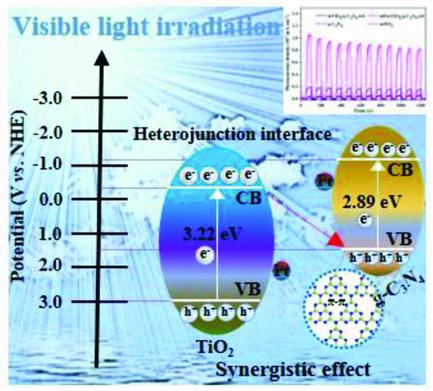当前位置:
X-MOL 学术
›
Adv. Funct. Mater.
›
论文详情
Our official English website, www.x-mol.net, welcomes your feedback! (Note: you will need to create a separate account there.)
Controllable Interface‐Induced Co‐Assembly toward Highly Ordered Mesoporous Pt@TiO2/g‐C3N4 Heterojunctions with Enhanced Photocatalytic Performance
Advanced Functional Materials ( IF 19.0 ) Pub Date : 2018-10-16 , DOI: 10.1002/adfm.201806214 Yidong Zou 1 , Beibei Yang 1 , Yang Liu 2 , Yuan Ren 1 , Junhao Ma 1 , Xinran Zhou 1 , Xiaowei Cheng 1 , Yonghui Deng 1, 3
Advanced Functional Materials ( IF 19.0 ) Pub Date : 2018-10-16 , DOI: 10.1002/adfm.201806214 Yidong Zou 1 , Beibei Yang 1 , Yang Liu 2 , Yuan Ren 1 , Junhao Ma 1 , Xinran Zhou 1 , Xiaowei Cheng 1 , Yonghui Deng 1, 3
Affiliation

|
Titania‐based materials have aroused great attention in energy conversion and photocatalytic degradation, but they suffer from the drawbacks of fast electron–hole recombination and narrow light‐adsorption range. Here, a series of heterojunction mesoporous TiO2/g‐C3N4 (mTiO2/g‐C3N4) composites with improved light‐adsorption capacity and efficient light‐capturing property are designed through a novel solid–liquid interface induced co‐assembly strategy and controlling the interface property of g‐C3N4. Through introducing Pt precursor during the synthesis, ultrasmall Pt nanoparticles are in situ generated in the mTiO2/g‐C3N4 composites, forming mesoporous Pt@TiO2/g‐C3N4 (mPt @ TiO2/g‐C3N4‐4.0) with abundant surface active sites, and huge heterojunction interfaces. The obtained mPt @ TiO2/g‐C3N4‐4.0 photocatalysts have narrow band gap (≈2.96 eV) and superior performance in promoting separation of photogenerated charge carriers. They show ultrahigh photocurrent density (≈8.3 µA cm−2) that is five times higher than that of mTiO2/g‐C3N4‐4.0 (≈1.6 µA cm−2) due to the effective charge separation between the semiconductors and Pt nanoparticles, as well as the synergistic effect at heterojunction interfaces. In addition, mPt @ TiO2/g‐C3N4 photocatalysts show excellent performance in photodegradation of rhodamine B with fast decomposition rate within 8 min. These results foresee the wide‐range applications of the composite photocatalysts potential candidates for solar‐to‐fuel conversion and environmental remediation.
中文翻译:

可控的界面诱导共组装成具有增强的光催化性能的高序介孔Pt @ TiO2 / g-C3N4异质结
基于二氧化钛的材料在能量转换和光催化降解方面引起了极大的关注,但是它们具有快速的电子-空穴复合和狭窄的光吸收范围的缺点。在此,通过新型固液界面诱导,设计了一系列具有增强的光吸收能力和有效的光捕获性能的异质结介孔TiO 2 / g-C 3 N 4(mTiO 2 / g-C 3 N 4)复合材料。共组装策略并控制g‐C 3 N 4的界面性质。通过在合成过程中引入Pt前驱体,在mTiO 2中原位生成超小Pt纳米颗粒/克-C 3层Ñ 4复合材料,中孔形成的Pt的TiO @ 2 / G-C 3 Ñ 4(MPT @的TiO 2 / G-C 3 Ñ 4 -4.0)具有丰富的表面活性位点,和巨大的异质结界面。将所得到的MPT @的TiO 2 / G-C 3 Ñ 4 -4.0光催化剂具有窄的带隙(≈2.96EV)和在促进光生载流子的分离性能优越。它们显示出超高的光电流密度(μA≈8.3厘米-2),其比mTiO的五倍2 / G-C 3 Ñ 4 -4.0(≈1.6μA厘米-2)是由于半导体与Pt纳米粒子之间有效的电荷分离以及异质结界面处的协同效应所致。此外,mPt @ TiO 2 / g-C 3 N 4光催化剂在罗丹明B的光降解中表现出出色的性能,并且在8分钟内分解速度很快。这些结果预示了复合光催化剂在太阳能转化为燃料和环境修复方面的潜在应用前景。
更新日期:2018-10-16
中文翻译:

可控的界面诱导共组装成具有增强的光催化性能的高序介孔Pt @ TiO2 / g-C3N4异质结
基于二氧化钛的材料在能量转换和光催化降解方面引起了极大的关注,但是它们具有快速的电子-空穴复合和狭窄的光吸收范围的缺点。在此,通过新型固液界面诱导,设计了一系列具有增强的光吸收能力和有效的光捕获性能的异质结介孔TiO 2 / g-C 3 N 4(mTiO 2 / g-C 3 N 4)复合材料。共组装策略并控制g‐C 3 N 4的界面性质。通过在合成过程中引入Pt前驱体,在mTiO 2中原位生成超小Pt纳米颗粒/克-C 3层Ñ 4复合材料,中孔形成的Pt的TiO @ 2 / G-C 3 Ñ 4(MPT @的TiO 2 / G-C 3 Ñ 4 -4.0)具有丰富的表面活性位点,和巨大的异质结界面。将所得到的MPT @的TiO 2 / G-C 3 Ñ 4 -4.0光催化剂具有窄的带隙(≈2.96EV)和在促进光生载流子的分离性能优越。它们显示出超高的光电流密度(μA≈8.3厘米-2),其比mTiO的五倍2 / G-C 3 Ñ 4 -4.0(≈1.6μA厘米-2)是由于半导体与Pt纳米粒子之间有效的电荷分离以及异质结界面处的协同效应所致。此外,mPt @ TiO 2 / g-C 3 N 4光催化剂在罗丹明B的光降解中表现出出色的性能,并且在8分钟内分解速度很快。这些结果预示了复合光催化剂在太阳能转化为燃料和环境修复方面的潜在应用前景。


























 京公网安备 11010802027423号
京公网安备 11010802027423号